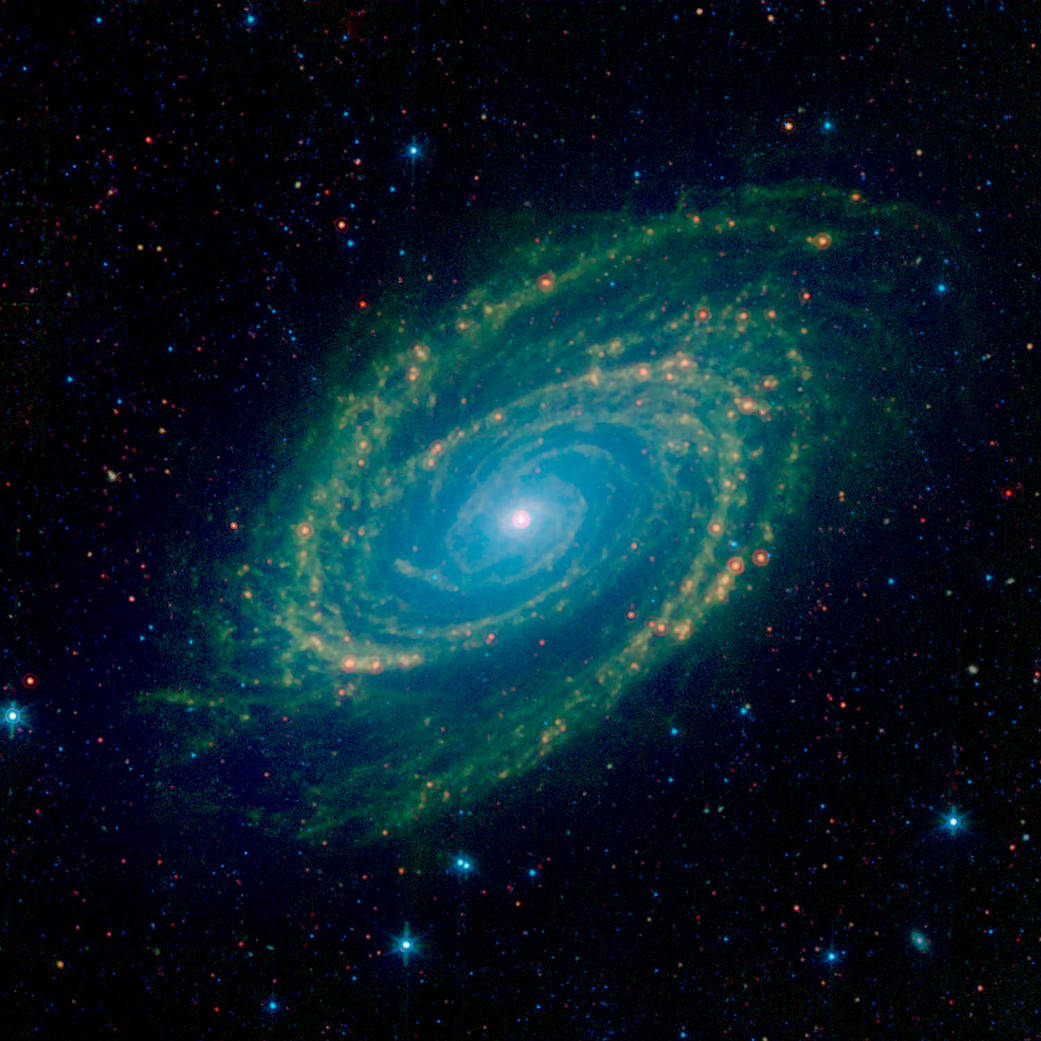Located in the northern constellation of Ursa Major, which also includes the Big Dipper, nearby galaxy Messier 81 is easily visible through binoculars or a small telescope. M81 is located at a distance of 12 million light-years.
M81 was one of the first publicly released datasets soon after the launch of the Spitzer Space Telescope in August 2003. On the occasion of Spitzer’s 16th anniversary this new image revisits this iconic object with extended observations and improved processing.
This Spitzer infrared image is a composite mosaic combining data from the Infrared Array Camera (IRAC) at wavelengths of 3.6/4.5 microns (blue/cyan) and 8 microns (green) with data from the Multiband Imaging Photometer (MIPS) at 24 microns (red).
The 3.6-micron near-infrared data (blue) traces the distribution of stars, although the Spitzer image is virtually unaffected by obscuring dust and reveals a very smooth stellar mass distribution, with the spiral arms relatively subdued.
As one moves to longer wavelengths, the spiral arms become the dominant feature of the galaxy. The 8-micron emission (green) is dominated by infrared light radiated by hot dust that has been heated by nearby luminous stars. Dust in the galaxy is bathed by ultraviolet and visible light from nearby stars. Upon absorbing an ultraviolet or visible-light photon, a dust grain is heated and re-emits the energy at longer infrared wavelengths. The dust particles are composed of silicates (chemically similar to beach sand), carbonaceous grains and polycyclic aromatic hydrocarbons and trace the gas distribution in the galaxy. The well-mixed gas (which is best detected at radio wavelengths) and dust provide a reservoir of raw materials for future star formation.
Image Credit: NASA/JPL-Caltech
邻近的梅西耶81星系位于大熊星座的北部,也包括北斗七星,通过双筒望远镜或小型望远镜很容易就能看到。M81距离地球1200万光年。
M81是2003年8月斯皮策太空望远镜发射后第一批公开发布的数据集之一。在斯皮策太空望远镜16周年纪念日之际,这幅新图像通过扩展观测和改进处理重新审视了这个标志性的天体。
这幅斯皮策红外图像是由红外阵列相机(IRAC)在3.6/4.5微米(蓝色/青色)和8微米(绿色)波段的数据与多波段成像光度计(MIPS)在24微米波段(红色)的数据合成而成。
3.6微米的近红外数据(蓝色)追踪了恒星的分布,尽管斯皮策的图像几乎不受尘埃遮蔽的影响,并显示了一个非常平滑的恒星质量分布,螺旋臂则相对较弱。
当我们移动到波长较长的波段时,旋臂就成为星系的主要特征。8微米的辐射(绿色)主要是由附近发光恒星加热的热尘埃辐射的红外光。星系中的尘埃沐浴在来自附近恒星的紫外线和可见光中。在吸收紫外线或可见光光子后,尘埃颗粒被加热并以较长的红外波长重新释放能量。尘埃颗粒由硅酸盐(化学性质类似于海滩沙)、碳质颗粒和多环芳烃组成,并追踪星系中的气体分布。这种混合良好的气体(在射电波段最容易探测到)和尘埃为未来恒星的形成提供了原料。
图片来源:NASA/JPL-Caltech



